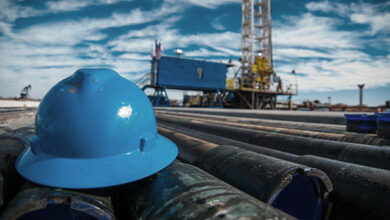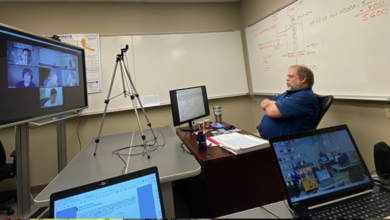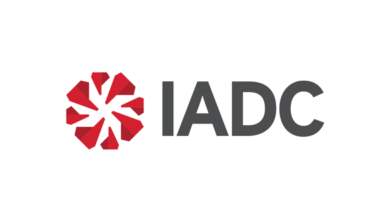Deployment from 6 deepwater rigs demonstrates module’s ability to suppress vortex-induced vibration, improve rig performance in harsh environments
By Kelsey Ware, Trelleborg Offshore

Meeting global demand for oil is achieved through the expansion of existing reservoirs both onshore and offshore, enhancements in technology and a persevering push to drill and produce in progressively challenging environments. Increasingly, offshore exploration and production of new oil and gas reserves is being achieved in locations and conditions that the industry defines as harsh weather. These regions are characterized by onerous winds and waves, along with high currents, typically in remote areas of the world, and frequently in deepwater.
Expanding operations in these high-current locations pushes the capabilities of drilling rigs and their equipment to the outer limit of operating envelopes. Success in this arena depends on the advancement of new equipment, technology and designs specifically targeted for deployment and operation in severe conditions.
One particular area of research and development receiving attention is how to expand rig operating envelopes in high currents. This is the suppression of current-induced hydrodynamic effects on the drilling riser.
Marine drilling risers characteristically have large outer diameters, an attribute exacerbated by the required use of buoyancy modules in deepwater operations. Hydrodynamic diameters regularly reach sizes of more than 50 in., causing high drag forces and, in instances where current velocities reach certain magnitudes, vortex-induced vibration (VIV) of the riser.
Both of these limit the conditions in which the riser can be safely deployed, operated and retrieved, as these reactions drive the controlling riser system parameters of flex joint angles, drill string rotation, and fatigue damage of the riser and subsea stack, specifically the wellhead and casing program.
Spearheading this industry challenge is a new helically grooved buoyancy module technology. Designed with an integrated tri-start helical groove, the buoyancy design decreases the influence of in-line drag and crossflow lift forces through manipulation of the fluid-structure interaction. Passive variation in the point of fluid separation along the profile of the riser, which results from inconsistent sequential cross-sectional geometries and a change to fluid momentum traveling through the helical groove geometry, works to suppress vortex formation in a similar way to the mechanism employed in helical fin strakes. This process results in suppression of riser crossflow oscillations by up to 95% in the range of flow speeds, which are responsible for the most severe riser vibrations for traditionally shaped buoyancy.

Importantly, these VIV suppression capabilities are achieved without increasing the effective diameter of the riser, as the helix is formed through a groove rather than external fins. This fact, coupled with the altered streamline trajectories and delayed fluid separation along the grooves, produces a strong independence of the drag coefficient with respect to Reynolds number (i.e., current flow speeds).
This buoyancy module has an industry-leading average static drag coefficient value of 0.63 across the range of relevant Reynolds numbers for offshore operations.
A number of peer-reviewed industry publications were issued to document the physics behind the hydrodynamic performance discussed above. These findings were produced with industry support and later accepted by a number of key operators, who have subsequently begun including requirements for “built-in” VIV suppression in their tenders to drilling contractors.
The encompassing benefits of the helically grooved buoyancy module technology design are targeted at drilling operations in high-current conditions. Inclusion of the suppression mechanism into the body of the buoyancy modules eliminates the requirement for ancillary suppression equipment, such as fairings or riser fins. This results in an increase in free deck space and reduces the number of required support vessel supply runs, a significant time- and cost-saving measure for campaigns in remote areas and challenging sea conditions.
The elimination of ancillary suppression equipment additionally speeds up running and retrieval times for a riser to an equivalency of a standard riser string with traditional buoyancy. It also removes the possibility of dropped objects in the moonpool and lost equipment during operations and maximizes the available time for a drilling rig to react to a weather event.
Commercialization of this technology is the product of three years of joint development between Diamond Offshore Drilling and Trelleborg’s offshore operation. The equipment design and qualification project included years of computational fluid dynamic studies and optimization of groove geometry. It culminated in a comprehensive large-scale test program and a monitored full-scale field deployment.
Harris Reynolds, Director of R&D for Diamond Offshore, stated: “We are committed to delivering fresh perspectives and solving complex deepwater challenges. For efficient operations in all conditions, especially high-current environments around the globe, this means equipping our vessels with the best technology. Our development of helically grooved buoyancy with Trelleborg is an extension of our commitment to advance the capabilities of the offshore drilling industry through innovation.”
To date, this buoyancy module technology has been manufactured for and installed on six drilling rigs, including both drillships and semisubmersibles, representing more than 15,000 ft of upgraded buoyancy, with additional depth breaks scheduled for manufacture in 2020. A track record has emerged that demonstrates the ability to produce helically grooved buoyancy modules that are equivalent in stacking strength, incorporate identical important safety features, such as the module integrity system, and do not sacrifice on uplift compared with traditional buoyancy designs.

Successful deployments have occurred in multiple deepwater regions around the globe, including the Gulf of Mexico, the North Sea and South Africa. Simplification of drilling riser operations in these regions stemming from the use of this buoyancy module has shown significant benefits.
“Since 2016 we have engaged in a multimillion-dollar program to upgrade the buoyancy on each of our four Blackship vessels and our most advanced sixth-generation semisubmersible, the Ocean GreatWhite, with helically grooved buoyancy,” Mr Reynolds said. “These improved buoyancy depth breaks help to minimize the adverse effects of operations in high-current regions, expanding on our leading offshore drilling capabilities.”
Marine drilling risers deployed with this unique technology expand a vessel’s drilling operating envelope. This results from the dual effects of suppressed riser oscillations and decreased drag forces, reducing fatigue damage of the riser and subsea stack, minimizing flex joint angles and improving riser deployment and retrieval in high-current regions. All of these factors culminate in an improved ability for drilling rigs to operate and deliver in demanding environments.
Odfjell Drilling selected this buoyancy system as part of its success at the Brulpadda prospect offshore South Africa, a location that is widely regarded as one of the most challenging in the world.
Thomas Borsholm, Principal Engineer Rig Design for Odfjell, said, “Successful drilling operations in the harsh conditions of the Brulpadda prospect with the Deepsea Stavanger semisubmersible, resulting in significant oil and gas discoveries and a subsequent multiwell drilling contract, substantiate Odfjell’s segment-leading expertise in the field of ultra-deepwater and harsh weather environments.
Designed with an integrated tri-start helical groove, the buoyancy design decreases the influence of in-line drag and crossflow lift forces through manipulation of the fluid-structure interaction.
“Drilling operations in such harsh conditions as experienced on the Brulpadda field require engineering solutions with focus on providing redundancy for all critical functions. In order to ensure robust VIV suppression, buoyancy module technology was utilized in combination with other VIV suppression solutions, ensuring functionality under challenging metocean conditions. Our investment in this technology ensures drag-reduction and VIV suppression capabilities to be readily available for further operations in the harsh conditions of South Africa, as well as future endeavors.”
The trend of expanding drilling and production operations in high-current environments is set to continue through the 2020s. The challenges these environments present are significant. However, by employing the correct equipment, technologies and designs specifically tailored for such conditions, as well as experience and expertise, these challenges also present significant opportunity to those willing to step up and overcome them.
The most influential equipment design advancements are those that deliver improved performance while minimizing the changes they introduce into holistic system design and original standard operating procedures. This buoyancy module technology is specifically manufactured to integrate into offshore riser handling, running, operation, retrieval and storage without necessitating changes compared with traditional buoyancy designs used in the industry for decades.
Passive manipulation of the fluid structure interaction eliminates the possibility of mechanical fouling and ensures valuable motion suppression properties are available on each riser deployment. Rigorously tested, with an expansive track record in some of the most challenging offshore conditions, the technology has expanded the operability windows for offshore drilling rigs, facilitating the continued exploration of high-current regions around the globe. DC
Lai, L. “VIV-Mitigating Buoyancy Module Performance Characterization Using Comp-utational Fluid Dynamics,” Proc Offshore Technology Conference. OTC 29032. 2018.
Gaskill C. & Wu J. & Yin D. “Full-Scale Reynolds Number VIV Testing of Tri-Helically Grooved Drill Riser Buoyancy Module,” Proceedings of the 37th International Conference on Offshore Mechanics and Arctic Engineering. OMAE2018-78605. 17-22 June 2018.
Lai, L. “Tri-Helically Grooved Buoyancy Hydrodynamics Considering Surface Rough-ness using 3D CFD” Proc International Society of Offshore and Polar Engineers. June 16-21, 2019.




